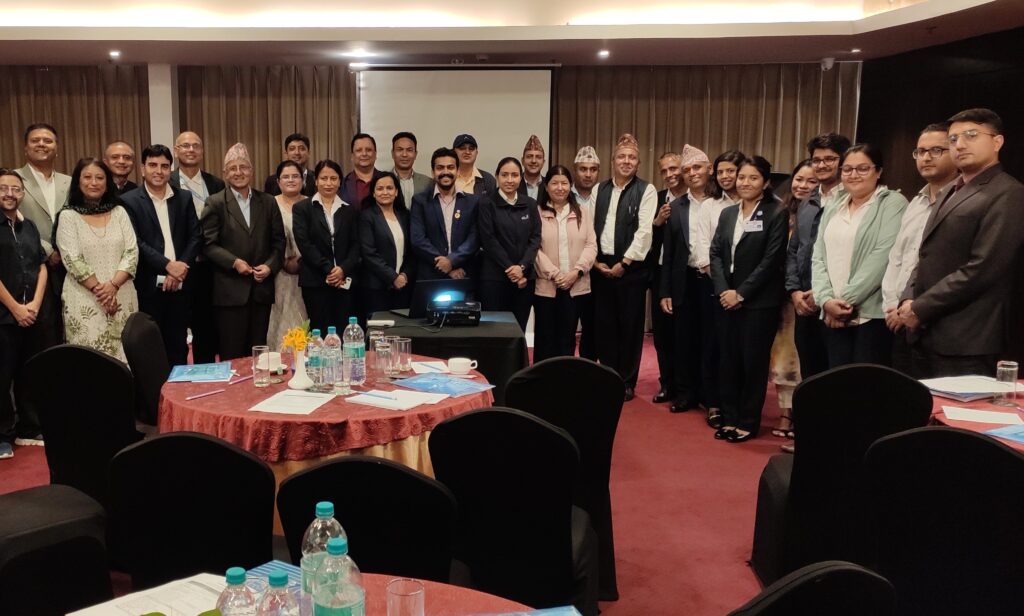Capacity Building of National Designated Authority, Development of Nepal’s Country Programme to the Green Climate Fund and Developing Strategies for Private Sector Investment for Low Emissions and Resilience

CENTER FOR GREEN ECONOMY DEVELOPMENT NEPAL / ETA CONSULT & PSPL– JV
CLIENT: Alternative Energy Promotion Centre (AEPC),
OFFICE ADDRESS: Mid-Baneshwor, Kathmandu, Nepal
FINANCING AGENCY: Green Climate Fund Readiness and Preparatory Support Programme Grant (AEPC)
Project Summary
Contract No: AEPC/GCF/RFP/2022/23-02
Project Agreement Date: 20 April, 2023
Project Completion Date: 30 April, 2024
Project Period: 12 months
Nepal ranks as 9th most climate vulnerable country in the planet (GermanWatch, 2021). However, it only contributes 0.056 percent of global Greenhouse Gas (GHG) emissions (MoFE, 2021). Nepal is committed to addressing climate change challenges by enhancing the capacity of its institutions to adapt to the impacts and vulnerability. A detailed plan has been laid out in its second Nationally Determined Contributions (NDC). Across sectors, some key adaptation actions include improved institutional arrangements and governance, disaster tracking and monitoring, response and risk reduction, early warning systems, promotion of clean energy sources, capacity development in health care, land-use and infrastructure design and planning, as well as inclusive governance for women and marginalised communities (MoFE, 2021).
Nepal’s climate change management vision is achieving socio-economic prosperity by building climate-resilient society, ecosystems and net zero emission by 2045. Nepal’s long-term Strategy for Net Zero emission (LTS)[1] was approved by the Government of Nepal Cabinet on 2078-07-09 and submitted to the UNFCCC. The Ministry of Forests and Environment (MoFE) has also submitted the National Adaptation Plan (NAP)[2] to the UNFCCC. Nepal’s Long-Term Strategy (LTS) envisions bold policy step in social transformation and technological advancements that will lead to a carbon-neutral, inclusive, and climate resilient future. The LTS established that Nepal’s total carbon dioxide (CO2) emissions in 2019 was 23 million Metric tons carbon dioxide equivalent (mMtCO2e). This amount is expected to rise to 34 mMtCO2e in 2030 and 79 mMtCO2e in 2050. In 2019, the non-energy-related emissions accounted for 46 per cent of net CO2 emissions and the energy sector accounted for 54 per cent. In the reference scenario, non-energy source CO2 emissions from Industrial Processes and Product Use (IPPU), Agriculture, Land Use, Land Use Change, and Forestry (AFOLU or Agriculture and LULUCF) and waste sectors would gradually decrease to 32 per cent of total emissions by 2050. This is shown in Figure 1 (GoN, 2020).
According to the Third National Communication (TNC) to the UNFCCC, Nepal has indicated a relative increase of greenhouse gas emission compared to the year 1990 level (GoN, 2021). This was reported in Nepal’s NDC[3] that was submitted in 2020. The NDC comprises of sectoral activity-based targets that are based on the Greenhouse Gas Inventory reported by the TNC. The TNC estimated the net GHG emissions of 31,998.91 Gg CO2 eq. using the base year 2011. The direct GHG emissions from energy and non-energy sources are estimated as follow: Energy: 14713.36 Gg CO2 eq. (46%); IPPU: 379.80 Gg CO2 eq.; AFOLU: 15982.16 Gg CO2 eq.; and Waste: 923.59 Gg CO2 eq. (56%). So essentially, the share of emissions from energy and non-energy sources remains the same in 2011 and 2019.
Context and Objectives of the NDA Capacity Development Project
Context of the Project
The Government of Nepal (GoN) is a Party to the United Nations Framework Convention on Climate Change (UNFCCC) and has ratified the Paris Agreement (MoFE, 2021). Regarding the climate finance, Article 4.3 of the UNFCCC states that “the developed country Parties and other developed Parties included in Annex II shall provide new and additional financial resources to meet the agreed full costs incurred by developing country Parties in complying with their obligations. The implementation of these commitments shall consider the need for adequacy and predictability in the flow of funds and the importance of appropriate burden sharing among the developed country Parties” (UNFCCC, 1992). Moreover, Article 4.4 of the Convention has particularly emphasized to “assist the developing country Parties that are particularly vulnerable to the adverse effects of climate change in meeting costs of adaptation to those adverse effects.” As the most climate vulnerable country Nepal deserves the priority in access the climate finance from international sources including the GCF. Nepal prepared and submitted its second NDC in December 2020.
The NDC implementation plan was prepared and submitted in October 2022. It was approved by the Environment Protection and Climate Change Management National Council (EPCCMNC) chaired by the Prime Minister of Nepal on 14/7/2079 (MoFE, 2022).
The key objectives and scope of the implementation plan includes:
- Activities that encompass key milestones, measurement indicators, reporting and verification, responsibilities and indicative budgeting
- A summary of the adaptation initiatives specified in the National Adaptation Plan (NAP)
- Clarity on the roles and responsibilities of federal, provincial and local governments, line agencies and stakeholders, including coordination and communication mechanisms.
- A financing mechanism to cover the costs of the various activities by elaborating on climate finance contributions from the government, development partners, international climate funds, and the private sector.
